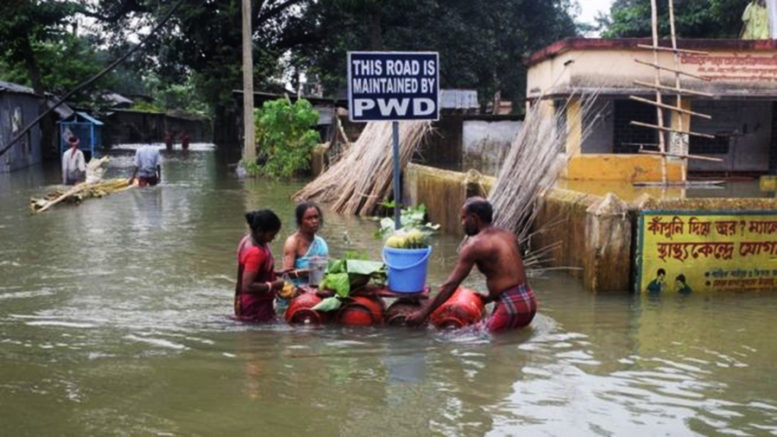While we all feel for those who have suffered losses in the Houston floods and have been moved by outpouring of support they have received, it remains that much of the world and media have been silent on the much more extensive flooding that has occurred in South Asia and the more desperate plight of what often poor communities living in this part of the world. Farrah Plummer writes about it (The New Daily 2 September 2017) and points out the lack of an adequate international response to a catastrophe that has caused a significant loss of life and enormous damage to the countries that have been affected.
While Australian media has been saturated with coverage of the disastrous flooding in the US town of Houston, a far more damaging and unfolding deadly humanitarian catastrophe is taking place.
Millions of people in South Asia are in need of urgent, life-saving support after weeks of torrential rain and catastrophic flooding in Nepal, India and Bangladesh.
Humanitarian agencies say at least 1400 lives have been lost in the disaster and more than 45 million people adversely affected by incessant sheets of rain across the three countries.
The floods are also assaulting Pakistan, with 15 people confirmed dead in Karachi and commercial and industrial activities paralysed across the country.
On Saturday, UNICEF estimated almost 16 million children and their families were in need of live-saving support.
While South Asia frequently suffers flooding during the monsoon season, between the months of June and September, aid agencies have deemed these particular floods “catastrophic”.
Wide-scale flooding stretching across the Himalayan foothills has caused landslides and washed away tens of thousands of homes and vast swathes of farmland.
In India, a multi-story residential building collapse in the capital city of Mumbai claimed 33 lives, left 15 injured and dozens more buried in the rubble.
Rescue workers and residents look for survivors at the site of a building collapse in Mumbai on August 31 after days of heavy rain swamped the city.
Meanwhile in Nepal, 150 people are reported dead, 65,000 homes damaged, 64,000 hectares of crops destroyed and 81,000 people affected.
More than 8 million people, including 3 million children, have been affected by the flooding in Bangladesh.
More than 140 people have died in the country and over 697,000 houses have been damaged or destroyed, according to the International Red Cross.
Close to 700,000 houses have been destroyed and more than 1300 cases of water-borne diseases have also been reported by UNICEF staff in Bangladesh.
“These are some of the worst floods we’ve seen in South Asia in decades and the impact is likely only going to get worse,” Madara Hettiarachchi, Christina Aid’s humanitarian head in Asia, said in a statement.
The deluge in Mumbai – which saw nearly a month’s average rainfall in a single day – halted train services and lead to flight cancellations.
Heavy monsoon rains have brought Mumbai to a halt in areas like Sion, Kings Circle, Kurla, Bandra, Mahim, Dadar, and Matunga remain flooded
Suffering in silence
Despite the unfolding crisis in the South Asian region, news coverage has been scarce, with tropical storm Harvey in the U.S. state of Texas garnering most the headlines. Those floods have so far claimed 44 lives and displaced 1 million people.
UNICEF Australia director of communications and fundraising Jennifer Tierney told The New Daily the scale of the crisis in South Asia was “phenomenal” and should receive consistent, headline attention.
“It has had some coverage, but any news consumer in Australia could see (Hurricane Harvey in) Houston has received far more,” Ms Tierney said.
Ms Tierney, who has worked in humanitarian communications for the last 12 years, said it was common for media consumers to empathise if they could imagine themselves in a crisis.
“When you’re sitting in a suburb of Sydney and see a house like your own getting destroyed (in Houston, Texas), it feels familiar,” she said, adding: “The media coverage ‘picks up’ that closer identity and runs with it.”
Ms Tierney said the lack of coverage also pointed to a “shrinking” number of reporters in the news media with even large news bureaus struggling to offer eyewitness coverage.
“Yes, it’s easier to relate to someone that experiences life the way you do, but what we have to remember at the end of the day is that a mother whose child’s life is at risk is the same, no matter where they are. Suffering is suffering.”
Oxfam Australia’s humanitarian response manager Meg Quartermaine told the The New Daily during the monsoon season in South Asia, some flooding was normal, but the current level of flooding was “unusual and unheard of”.
Ms Quartermaine said flooding and natural disasters caused by Hurricane Harvey in the United States and the severe monsoon flooding in South Asia had affected millions of people and killed more than a thousand people.
“People need assistance in both situations but it’s important to note the differences between the distasters and keep media attention on both,” she said.


Be the first to comment on "South Asia floods is the world’s forgotten catastrophe"